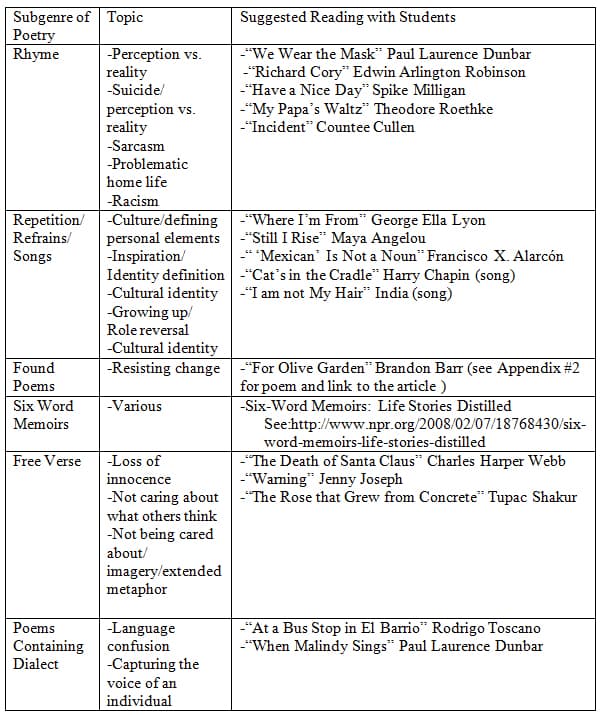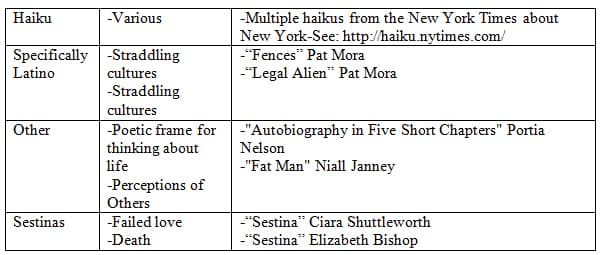Student Readings


Explanation of Selected Readings
I have grouped student readings loosely by subgenres of poetry. Based on each subgenre, I am going to briefly explain why I selected the readings that I did and how they fit within the larger context of identity, major life changes, and also how they function as mentor texts that students can look to for form in producing their poetry.
Rhyme
There are five poems that are included in the rhyme subgenre that will be read as part of the unit:
- "We Wear the Mask" Paul Laurence Dunbar
- "Richard Cory" Edwin Arlington Robinson
- "Have a Nice Day" Spike Milligan
- "My Papa's Waltz" Theodore Roethke
- "Incident" Countee Cullen
Each of these poems uses rhyme as a method of linking ideas together to create flow through extensive use end rhyme. By looking at these poems, I hope that students see that rhyme can be used in sophisticated ways to link ideas. I also hope that students unpack issues of identity in each poem. In the case of "We Wear the Mask," it is hoped that students recognize issues of power that is embedded in covering up one's true feelings. In "Richard Cory," it is hoped that students will see how rhyme is used to create narrative flow, and by the end of the poem of the flow of the poem is broke by the suicide of Richard Cory, a person who seemingly had it all. This will allow for a chance for me to model sharing the story of Rudy, who serves as inspiration of the unit. In "Have a Nice Day," I want to highlight how rhyme is used to create an exchange between two people; another way that students can use the form of rhyming to address something difficult. The poem "My Papa's Waltz" creates an image of a less than ideal father that still clearly loves his child despite being seriously flawed. I believe this will resonate with a lot of my students; rhyme is used to create narrative flow. In "Incident," the speaker in the poem comes face-to-face with racism. I will highlight in my reading how rhyme's sing-song nature captures the speaker's childlike innocence that is shattered by experiencing racism.
Repetition/Refrains/Songs
There are three poems and two songs that are included in this subgenre that will be read as part of this unit:
- "Where I'm From" George Ella Lyon
- "Still I Rise" Maya Angelou
- " 'Mexican' Is Not a Noun" Francisco X. Alarcón
- "Cat's in the Cradle" Harry Chapin (song)
- "I am not My Hair" India (song)
The poem "Where I am From" uses repetition to consider the seminal elements that shape the speaker in the poem's existence. The repetition of "I'm from" in the poem holds ideas together and gets students to think about what the impact that a phrase that is repeated can have on a reading. Students will use the "Where I am From" poem as a mentor text to create their own version of the poem. "Still I Rise" was selected because I want students to see how Angelou uses the repetition of that line as an answer to the obstacles that the speaker in the poem has faced throughout her life. The ending of "I rise" being repeated also suggests movement and overcoming. "'Mexican' Is Not a Noun" is filled with repetition and parallel structures; it should cause good discussion because it is slightly provocative with its word choices and ideas. My hope is that it gets students to think about their culture in a slightly more nuanced manner. The "Cat's in the Cradle" is a song that addresses growing up and its impact on family. This song is powerful for students; when I share it with students I try to get them thinking about theme. As part of this unit, I also want to focus on how repetition and the refrain move the narrative along in the song. I will also get students to think about the effect of having a nursery rhyme as a refrain has on their listening/reading of the song. The song "I am not My Hair" focuses on identity; it begs the question, if I am not my hair, then what am I? I will also focus on this song on how a refrain is used for emphasis and cohesion.
Found Poems
"For Olive Garden" Brandon Barr (see Appendix #2 for poem and link to the article)
For found poetry, I am going to emphasize that poems can be found in almost anywhere. I will share my process. Students will look for their own found poems to share with others. Everyone will produce a found poem. This will also act as prior knowledge for later in the year when I have students create found poems in IWitness when we study the Holocaust: http://iwitness.usc.edu/SFI/Activity/Detail.aspx?activityID=86
Six Word Memoirs
Six-Word Memoirs: Life Stories Distilled
See: http://www.npr.org/2008/02/07/18768430/six-word-memoirs-life-stories-distilled
For six word memoirs, I will allow students to explore the website above to think about their lives or the life of someone dear to them. In addition to producing a six word memoir, they will need to write an explanation of the six word memoir is fitting. This will help me to understand my students better.
Free Verse
"The Death of Santa Claus" Charles Harper Webb
"Warning" Jenny Joseph
"The Rose that Grew from Concrete" Tupac Shakur
For free verse, I selected three very different types of poems that address issues of identity and life changes in different ways. In "The Death of Santa Claus," the poet addresses the theme of loss of innocence as Santa playfully dies as a child is being told that Santa does not exist. As with the poem that we read about the Christmas tree (which was really addressing a person embracing death) in seminar, sometimes it is good to create an alternate story/image/metaphor in order to address a difficult life change or element of identity. In a similar vein, "The Rose that Grew from Concrete" uses extended metaphor to think about something that has grown out of less than ideal circumstances. This poem will challenge my students to think beyond literal. "Warning" is a fun poem that will illustrate to students how to build ideas. She uses transitions in the poem and a question to mark the turn of the poem. It also gets students to think about how people change as they age.
Poems Containing Dialect
- "At a Bus Stop in El Barrio" Rodrigo Toscano
- "When Malindy Sings" Paul Laurence Dunbar
Both of these poems allow students to see the power of thinking intentionally about the speaker of a poem and capturing how that speaker's rhythm and cadence of speech. For "At a Bus Stop in El Barrio," I would read the part that is a heavy accent and have someone call the other part out. I would want students to think about the effect that dialect has in the poem and how accents affect communication. In similar fashion, "When Malindy Sings" is a poem that uses a different dialect put quickly puts the reader in a very different time and place. From both of these poems, students should see the potential of capturing dialect in their work.
Haiku
Multiple haikus from the New York Times about New York
See: http://haiku.nytimes.com/
The haikus that are on the New York Times website about New York address a variety of themes. I plan on letting students explore the website, find one they like, and talk about it with peers. I will focus on the power of haiku to create imagery. Students will create a few of their own.
Specifically Latino
- "Fences" Pat Mora
- "Legal Alien" Pat Mora
Even though my students are Latino, they face many issues related to identity and life changes that go beyond culture. For that reason, I have shied away from incorporating a ton of specifically Latino poetry. Even so, there is a poem in dialect and with repetition that also address issues that impact Latino students. Four poems I believe is a good number for readings without becoming repetitious and heavy-handed with cultural identity. Students will have the chance to explore cultural identity more through their writing should they choose to do so.
In the poem "Fences," issues of power arise as tourists are able to enjoy a beach that the people who live in the area cannot. I would want students to think about power relations in the poem and the poet's use of repetition at the end of the poem. In "Legal Alien," the poem suggests what it feels to be like between cultures; the speaker is clearly uneasy about not fitting in either American or Mexican culture. This poem should elicit a strong response from students who are straddling cultures.
Other
- "Autobiography in Five Short Chapters" Portia Nelson
- "Fat Man" Niall Janney
These two poems didn't fit with any other category, so I labeled them other. "Autobiography in Five Short Chapters" will serve as another possible form for student poetry to follow. In the poem, the speaker traces his/her back decision-making into stanzas. I believe the form will work for many students who struggle to organize their ideas in poetry. The poem "Fat Man" is a great poem to think about incorporating a turn or changed perspective on things.
Sestinas
- "Sestina" Ciara Shuttleworth
- "Sestina" Elizabeth Bishop
Both of these poems reveal the form of a sestina. The form of a sestina is another framework for students to follow to express their ideas. It is also a playful form that requires students to carefully select words that can be used in multiple ways. These two particular sestinas also happen to address topics that relate to the unit, love and death. The sestina is another potential frame for students to use to communicate ideas through poetry.

Comments: